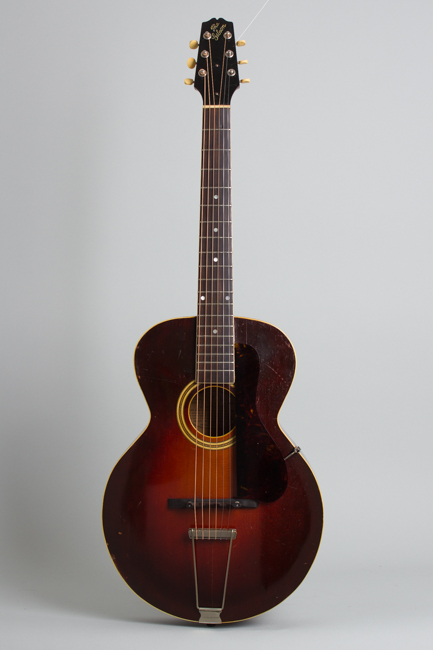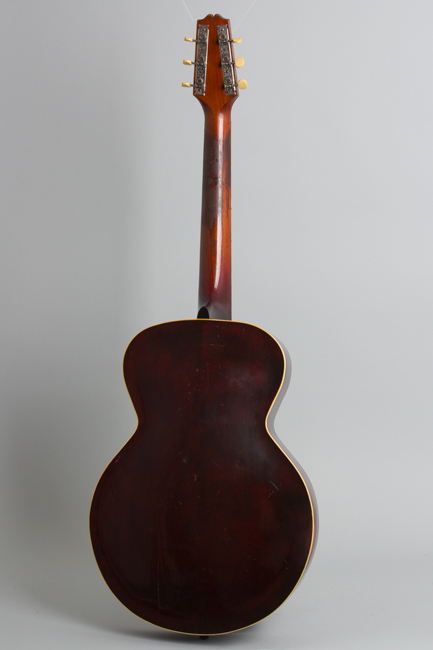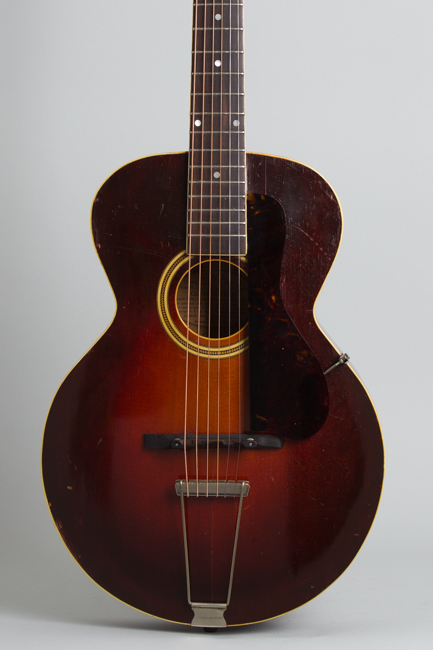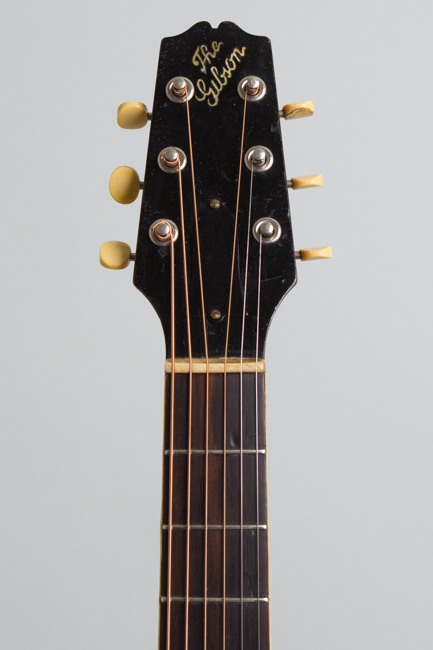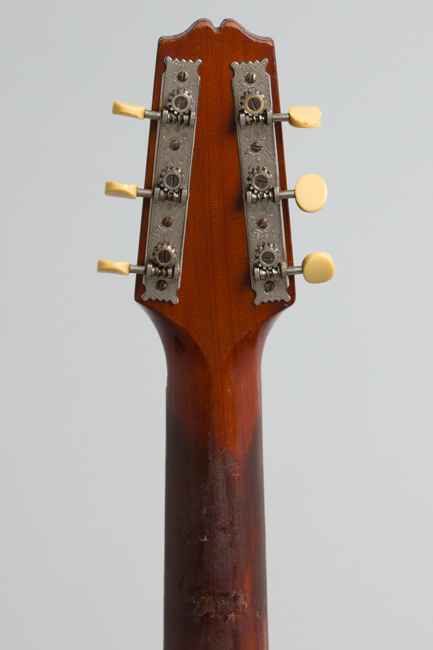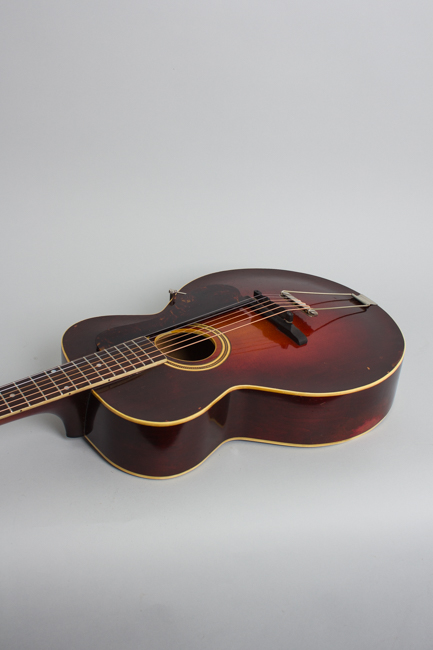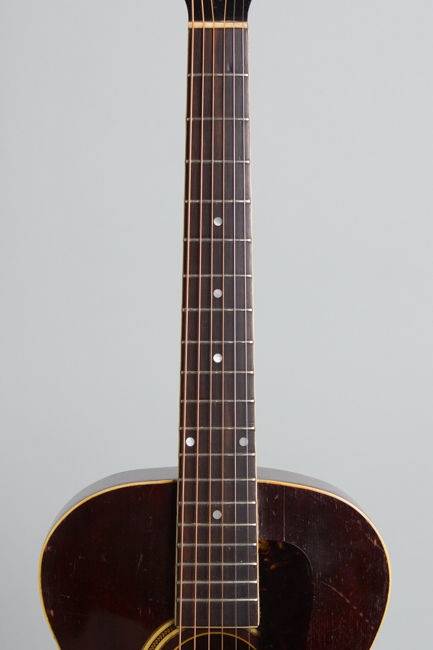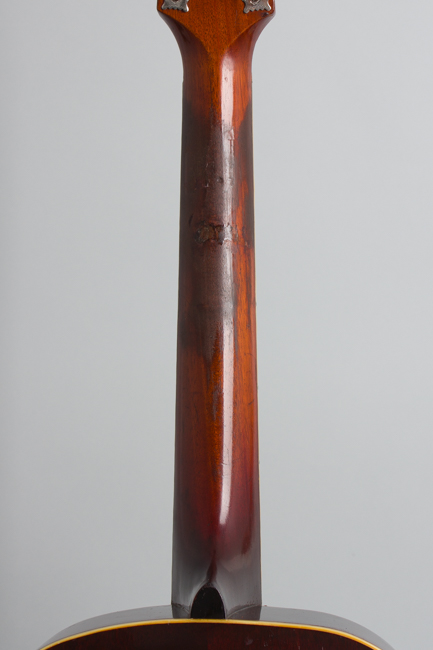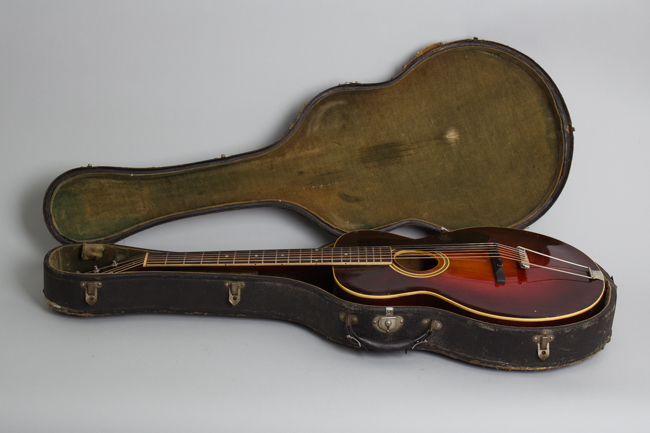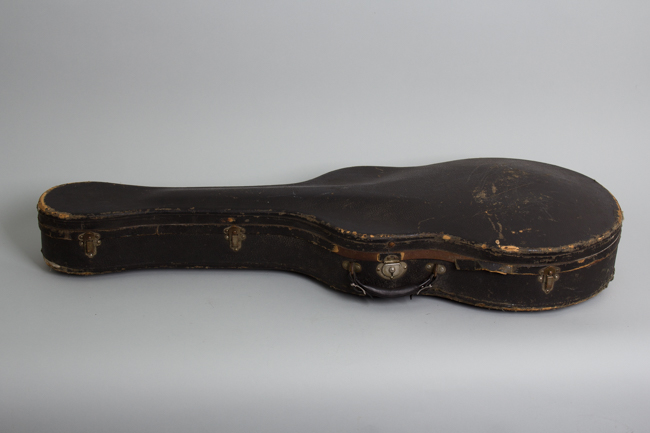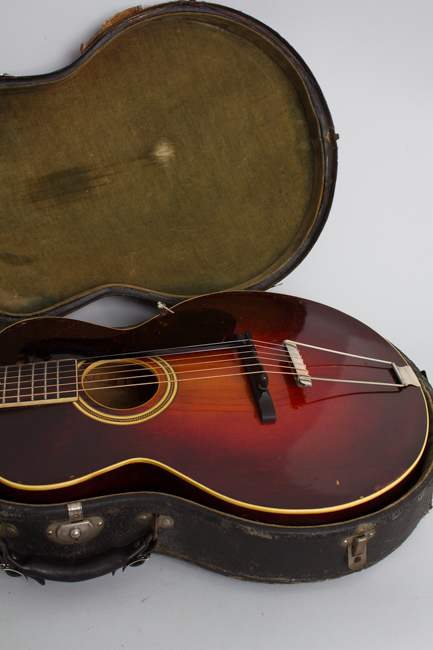Gibson L-3 Arch Top Acoustic Guitar (1925)
Gibson L-3 Model Arch Top Acoustic Guitar (1925), made in Kalamazoo, Michigan, serial # 77898, red sunburst varnish finish, birch back and sides, spruce top; mahogany neck with ebony fingerboard, original black hard shell case.
This is a lightly worn in but nice playing example of Gibson's original 1910-20s small-body archtops, the L-3. It was built in early 1925, just as the "Loar Era" was ending at Gibson. This L-3 was an older design, the company's mid-line archtop guitar, the fanciest model built on the small 13 3/4" carved-top chassis. It was priced at $100; well under the 16" $150.00 L-4 but in the mid-1920's that was still a lot of money for a guitar; a pearl trimmed, Brazilian rosewood Martin 00-42 could be had for just $10 more!
The L-3 features a daintier rounded bout body than its higher priced Gibson siblings but is a fairly showy guitar nonetheless. The single-bound top is finished in a rich dark red sunburst, the single multiply inlaid sound hole ring has a herringbone center layer. The L-3 carries the same basic set of then-new hardware as the larger L-4 with an adjustable ebony bridge, "wrap-under" trapeze tailpiece and raised celluloid pickguard. Another noticeable difference from the L-4 is a smaller round sound hole instead of a wide oval.
As "Master Loar" went around the factory many instruments beyond the Master Models benefitted from his sometimes pedantic presence; the carved spruce top on this '25 is a bit more thinly worked giving it a bigger, more open sound than most earlier examples. The neck has the brand-new adjustable truss rod with a slimmer, more smoothed out "V" profile than used before and the Loar-designed "snakehead" headstock used only in this period. Never a common model, as the '20s went on the L-3 become pretty much forgotten and would be phased out as the Depression hit.
This is a fairly rare instrument; in 1925 Gibson switched to producing primarily banjos at the expense of mandolins and guitars, a trend which would reverse itself after 1930 but too late to save the L-3. These smaller-bodied, round hole, carved-top guitars have a bright and barky sound with plenty of volume; this Loar-era L-3 is somewhat more open and richer toned than some we have had and sounds closer to a "normal" guitar! This diminutive round bout archtop may seem an eccentric design today but remains a charming reminder of the Gibson company's earlier periods, before the 1930s changed everything.
Overall length is 38 1/2 in. (97.8 cm.), 13 3/4 in. (34.9 cm.) wide at lower bout, and 3 3/8 in. (8.6 cm.) in depth, measured at side of rim. Scale length is 24 1/4 in. (616 mm.). Width of nut is 1 3/4 in. (44 mm.).
This guitar shows some general wear and re-worked replica parts but remains a very nice player. The original finish has only minimal fade to the deep red sunburst top. There are dings, dents and scrapes overall, most heavily to the top. The finish is worn well down to the wood on the back of the neck and less heavily upper rim. There is some capo wear to the back of the neck as well, with small dinks behind the second fret and what must have been a deep divot behind the 3rd visibly filled in.
The top has a repaired grain split off the front edge a bit below the fingerboard and the center seam has been re-sealed. The back has one repaired grain split off the back edge a couple of inches below the endpin. There are no other visible repairs. The engraved-plate Waverly tuners are the originals, the pickguard and bridge are carefully wrought repros in the original style. The tailpiece base and fork is original; the crossbar is period but from a slightly later guitar. The guitar was probably refretted with older style wire long ago; these have been more recently crowned down and play well. While not the cleanest of these we have had this is very fine playing and sounding Loar-era small-body Gibson archtop, complete with the worn-but-solid OHSC. Overall Very Good + Condition.
This is a lightly worn in but nice playing example of Gibson's original 1910-20s small-body archtops, the L-3. It was built in early 1925, just as the "Loar Era" was ending at Gibson. This L-3 was an older design, the company's mid-line archtop guitar, the fanciest model built on the small 13 3/4" carved-top chassis. It was priced at $100; well under the 16" $150.00 L-4 but in the mid-1920's that was still a lot of money for a guitar; a pearl trimmed, Brazilian rosewood Martin 00-42 could be had for just $10 more!
The L-3 features a daintier rounded bout body than its higher priced Gibson siblings but is a fairly showy guitar nonetheless. The single-bound top is finished in a rich dark red sunburst, the single multiply inlaid sound hole ring has a herringbone center layer. The L-3 carries the same basic set of then-new hardware as the larger L-4 with an adjustable ebony bridge, "wrap-under" trapeze tailpiece and raised celluloid pickguard. Another noticeable difference from the L-4 is a smaller round sound hole instead of a wide oval.
As "Master Loar" went around the factory many instruments beyond the Master Models benefitted from his sometimes pedantic presence; the carved spruce top on this '25 is a bit more thinly worked giving it a bigger, more open sound than most earlier examples. The neck has the brand-new adjustable truss rod with a slimmer, more smoothed out "V" profile than used before and the Loar-designed "snakehead" headstock used only in this period. Never a common model, as the '20s went on the L-3 become pretty much forgotten and would be phased out as the Depression hit.
This is a fairly rare instrument; in 1925 Gibson switched to producing primarily banjos at the expense of mandolins and guitars, a trend which would reverse itself after 1930 but too late to save the L-3. These smaller-bodied, round hole, carved-top guitars have a bright and barky sound with plenty of volume; this Loar-era L-3 is somewhat more open and richer toned than some we have had and sounds closer to a "normal" guitar! This diminutive round bout archtop may seem an eccentric design today but remains a charming reminder of the Gibson company's earlier periods, before the 1930s changed everything.
Overall length is 38 1/2 in. (97.8 cm.), 13 3/4 in. (34.9 cm.) wide at lower bout, and 3 3/8 in. (8.6 cm.) in depth, measured at side of rim. Scale length is 24 1/4 in. (616 mm.). Width of nut is 1 3/4 in. (44 mm.).
This guitar shows some general wear and re-worked replica parts but remains a very nice player. The original finish has only minimal fade to the deep red sunburst top. There are dings, dents and scrapes overall, most heavily to the top. The finish is worn well down to the wood on the back of the neck and less heavily upper rim. There is some capo wear to the back of the neck as well, with small dinks behind the second fret and what must have been a deep divot behind the 3rd visibly filled in.
The top has a repaired grain split off the front edge a bit below the fingerboard and the center seam has been re-sealed. The back has one repaired grain split off the back edge a couple of inches below the endpin. There are no other visible repairs. The engraved-plate Waverly tuners are the originals, the pickguard and bridge are carefully wrought repros in the original style. The tailpiece base and fork is original; the crossbar is period but from a slightly later guitar. The guitar was probably refretted with older style wire long ago; these have been more recently crowned down and play well. While not the cleanest of these we have had this is very fine playing and sounding Loar-era small-body Gibson archtop, complete with the worn-but-solid OHSC. Overall Very Good + Condition.
